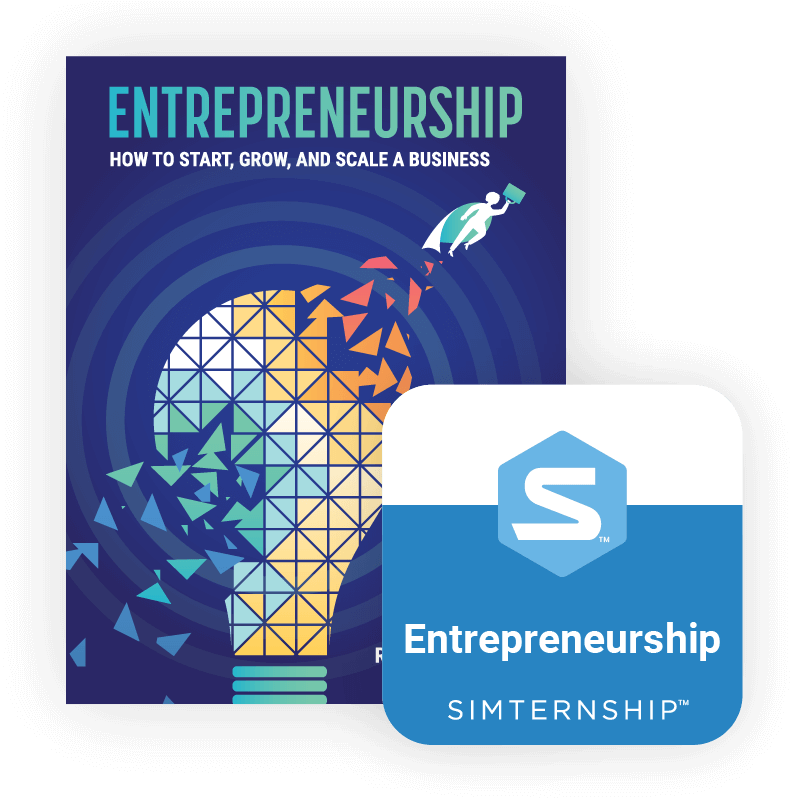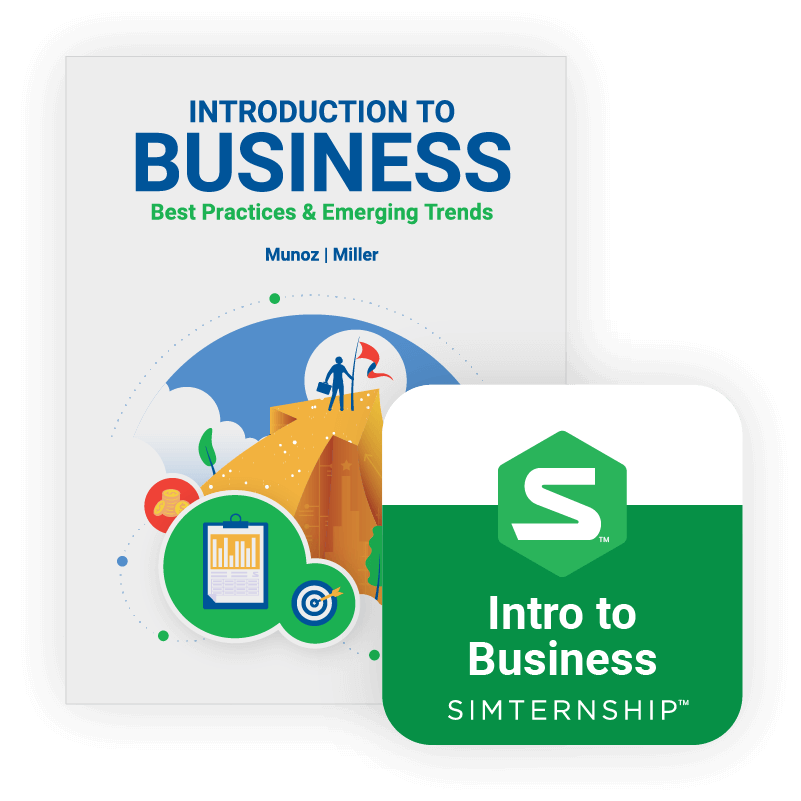The Entrepreneurship Simternship® + Courseware
Turnkey materials that turn your course into a master class
The Entrepreneurship Bundle contains everything you need to prepare students for entrepreneurial success! This bundle includes the Stukent Entrepreneurship Simternship, which allows your students to experience the pressures of running a start-up in a low-risk, secure learning environment.
The “Entrepreneurship” courseware approaches the entrepreneur’s journey from three unique angles, including how to make the right start-up decisions, scale a business, and analyze success.

Power your entrepreneurship course with experiential learning
The Stukent Entrepreneurship Simternship

Hands-on learning without limits
The Stukent Entrepreneurship Simternship asks students to research products, manage budgets, perform market research, secure investment funds, hire employees, and so much more.

Your students will master key entrepreneurship skills through:
Market research
Data analysis
Customer segmentation
Inventory management and forecasting
Budgeting
Pitching
Hiring and leadership
Retail strategy and partnerships
Key simulation learning objectives
Over the course of 10 rounds, your students will . . .
- Apply tactics for self-reflection and exploration that support entrepreneurial behaviors
- Perform market research to determine an ideal target market
- Create a target persona and value proposition statement based on research analysis
- Order sample products and test their performance in the market
- Manage a budget that includes placing product orders, ad spending, and hiring employees
- Manage inventory based on forecasting and sales performance
- Secure additional investment funds based on business valuation and equity
- Peer review investment pitches
- Choose brick-and-mortar stores to sell products
- Hire an employee
Stukent Simternships
Employ Students
in Career-Relevant Learning
A Stukent Simternship® is a career-relevant, work-integrated learning experience that helps your students connect classroom concepts to real-world tasks.
In a Simternship, students become marketing managers, PR officers, entrepreneurs, SEO specialists, accountants, and more. They will interact with simulated supervisors and coworkers, perform realistic tasks, and build their confidence within the safety of a simulated environment.
Hands-on Learning without the Hassle
Stukent Simternships integrate with your favorite LMS platforms
Single Sign-on
Grade Book Syncing
Deep Linking
Rostering


Practice, Meet Pedagogy
Pair Your Simternship with Stukent Courseware
Stukent courseware aligns with your Simternship, giving your students a solid foundation for success.
Stukent Courseware
Courseware that puts classroom concepts into professional contexts
Stukent courseware goes beyond the limitations of the printed textbook, pairing powerful instructional resources for you with an annually updated, concise text for students.


An Authoritative Text + Robust Instructional Resources
The “Entrepreneurship” courseware
The “Entrepreneurship” courseware introduces your students to the theory, processes, and mindset of starting a business. This 10-chapter courseware follows the journey of a new entrepreneur, Jasmine Abrams, to help students connect textbook theory to real-world applications.
Packed with teaching tools and customizable resources, this courseware is a robust yet easy-to-implement entrepreneurship curriculum!
What’s Inside
Table of Contents
Introduces the entrepreneurship mindset by exploring self-awareness, strategic planning, and the unique lifestyle of entrepreneurs.
Explores the essentials of start-up decisions, from choosing what to sell to leveraging research and selecting the right business models and structures.
Introduces the fundamentals of branding, from essential components to creating a distinct brand voice.
Examines how to legitimize your business with legal protections, financial management, and funding strategies that support long-term success.
Explores strategies for building brand value through relationships, value-driven decisions, customer insights, and effective use of customer research.
Introduces the essentials of marketing and selling your brand, from distinguishing marketing and sales to entrepreneurial sales strategies and advertising.
Explores key strategies for managing your business, from hiring and leading your first team to fostering a strong culture and effective communication.
Shares practical tips for managing business finances, including cash flow tracking, financial organization, and securing funds.
Examines the challenges of business growth, from scaling effectively to executing strategies that drive sustainable success.
Explores how to define and assess business success with key metrics that reveal both immediate health and long-term financial strength.
Key courseware learning objectives
In this courseware, your students will ...
- Develop an entrepreneurial mindset
- Explore how emotional intelligence impacts entrepreneurs
- Apply different models to build a business
- Understand primary and secondary target markets
- Explore how market research impacts business decisions
- Identify essential components of a brand
- Articulate a brand story and unique value propositions
- Manage business finances
- Apply for billing and funding in a business venture
- Identify how to expand service or product offerings

200+ Embedded Educator Resources
Everything You Need to Teach
Your Best Course
- 10 lesson plans
- 10 auto-graded quizzes
- 10 lecture slide decks
- 6 Expert Session videos
- 2 case studies
- 126 essay questions
- Quiz banks
- Worksheets
- Assignments
- Class projects and journal prompts
- 1 cumulative project
About the Authors

Dr. Jen Riley
Professor at Vanderbilt University
Dr. Jen Riley is an award-winning author and marketing professor at Vanderbilt University. Her research spans marketing, professional sales, and entrepreneurship, investigating consumer interactions with social media and digital marketing, technology’s role in the professional sales process, and innovative teaching techniques for student engagement and soft skill development. As a professor, entrepreneur, and consultant, Dr. Riley is dedicated to guiding students in building skills and discovering their passions, assisting clients of all sizes in marketing and sales, and helping start-ups and small businesses succeed! She enjoys movies, competitive public speaking, and cherishing family moments in her spare time.

Stuart Draper
Founder of Stukent
Stuart Draper has taught hundreds of college students in digital marketing as an adjunct faculty member at Brigham Young University – Idaho. Before founding Stukent Inc., Draper founded the successful digital marketing agency Get Found First. He has hired, trained and mentored dozens of college students as online marketing interns and employees.
One Platform. Hundreds of Resources. Unlimited Possibilities.
Additional resources for creating a great course
Always have the
latest edition
This courseware contains robust instructional resources for educators and students. Best of all, the Stukent team updates the courseware annually, which means your curriculum will always be on the cutting edge of your industry.
Support for you,
support for students
The Stukent Support Team helps students and educators get the most out of their Stukent experience. Whether you need help logging into your Stukent Simternship, navigating your courseware, or understanding simulation results, we’re here to help!
Stukent Events
Join us for webinars, product launches, and more!
Trusted by the World’s Most Innovative Institutions








